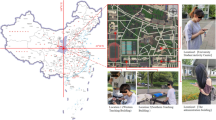Abstract
Winter clothing provides insulation for almost all of a person’s body, but in most situations, a person’s face remains uncovered even in cold windy weather. This exploratory study used thermal imagery to record the rate of cooling of the faces of volunteers in a range of winter air temperatures and wind speeds. Different areas of the faces cooled at different rates with the areas around the eyes and neck cooling at the slowest rate, and the nose and cheeks cooling at the fastest rate. In all cases, the faces cooled at an approximately logarithmic decay for the first few minutes. This was followed by a small rise in the temperature of the face for a few minutes, which was then followed by an uninterrupted logarithmic decay. Volunteers were told to indicate when their face was so cold that they wanted to end the test. The total amount of time and the facial temperature at the end of each trial were recorded. The results provide insight into the way faces cool in uncontrolled, outdoor winter conditions.



Similar content being viewed by others
References
Brown RD, Gillespie TJ (1995) Microclimatic landscape design: creating thermal comfort and energy efficiency. Wiley, New York
Castellani JW, Young AJ (2016) Human physiological responses to cold exposure: acute responses and acclimatization to prolonged exposure. Auton Neurosci 196:63–74
Gavhed D, Mäkinen T, Holmér I, Rintamäki H (2000) Face temperature and cardiorespiratory responses to wind in thermoneutral and cool subjects exposed to −10 °C. Eur J Appl Physiol 83(4–5):449–456
Gavhed D, Mäkinen T, Holmér I, Rintamäki H (2003) Face cooling by cold wind in walking subjects. Int J Biometeorol 47(3):148–155
Lee C, Ory MG, Yoon J, Forjuoh S (2013) Neighborhood walking among overweight and obese adults: age variations in barriers and motivators. J Community Health 38:12–22
Mäkinen T, Gavhed D, Holmér I, Rintamäki H (2000) Thermal responses to cold wind of thermoneutral and cooled subjects. Eur J Appl Physiol 81(5):397–402
Shabat YB, Shitzer A (2012) Facial convective heat exchange coefficients in cold and windy environments estimated from human experiments. Int J Biometeorol 56(4):639–651
Shabat YB, Shitzer A, Fiala D (2014) Modified wind chill temperatures determined by a whole body thermoregulation model and human-based facial convective coefficients. Int J Biometeorol 58(6):1007–1015
Tikuisis P, Ducharme MB, Brajkovic D (2007) Prediction of facial cooling while walking in cold wind. Comput Biol Med 37(9):1225–1231
Tucker P, Gilliland J (2007) The effect of season and weather on physical activity: a systematic review. Public Health 121:909–922
US Department of Health and Human Services (2015) Step it up. The Surgeon General’s call to action to promote walking and walkable communities
Westphal JM, Schweitzer J, Mullins L, Bhawani S (2012) Factors affecting seasonal walkability in a cold climate community: a case study of East Lansing, Michigan, in collaboration with Michigan State University. Transylvanian Review of Administrative Sciences 8(SI):158–183
Author information
Authors and Affiliations
Corresponding author
Rights and permissions
About this article
Cite this article
Briggs, A.G.S., Gillespie, T.J. & Brown, R.D. Measuring facial cooling in outdoor windy winter conditions: an exploratory study. Int J Biometeorol 61, 1831–1835 (2017). https://doi.org/10.1007/s00484-017-1368-3
Received:
Revised:
Accepted:
Published:
Issue Date:
DOI: https://doi.org/10.1007/s00484-017-1368-3




